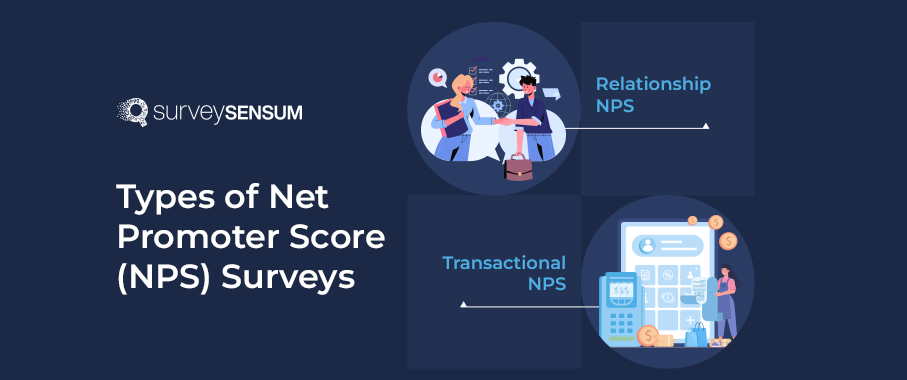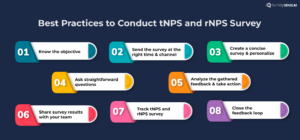5 Ways For Improving Collaboration in Software Teams
Read More

Net Promoter Score (NPS) is one of the popular CX metrics in the business offering valuable insights to the businesses to measure customer loyalty and gauging the overall satisfaction levels.
By understanding your NPS, you can make informed decisions to enhance your products, services, and, ultimately, your customer experience.
However, have you ever stopped to consider that there might be different types of Net Promoter Score surveys?
If not, don’t worry—you’re not alone.
Many businesses overlook the various types of NPS surveys and fail to leverage their full potential.
In this blog, we aim to shed light on the different types of Net Promoter Score surveys and their distinct uses. We’ll delve into the importance of each type and guide when and how to implement them effectively with Net Promoter software.
You know what NPS is and how to calculate it. So, let us jump directly into its types.
Types of Net Promoter Score (NPS)
4 Key Differences Between Transactional and Relationship NPS Surveys
Transactional NPS vs Relationship NPS – Which One Should You Go for?
Best Practices to Gather tNPS and rNPS Surveys
There are three types of Net Promoter Score surveys that many customer-centric businesses use to listen to their customers and identify their pain points. The received data helps businesses to find areas of improvement to improve their products and services.
Following are the 3 types of NPS:
Let’s begin with the transactional Net Promoter Score survey also known as tNPS.

As the name suggests, transactional NPS deals with a specific transaction. It helps measure the customer experience of a particular transaction that concluded recently.
The question that you can ask in the tNPS survey is
After sending a tNPS survey, you will receive instant feedback on how your customers feel post-transaction. If you receive negative feedback, you can take immediate action, and if you receive positive feedback, you can share it with your team to boost their morale.
You can conduct a tNPS survey on the following touchpoints:
1. Onboarding
How was your overall onboarding experience on a scale of 0-10?
2. Post-customer service calls
On a scale of 0-10, how likely are you to recommend us to a friend or colleague based on the resolution of your recent customer support call?
3. New product launch or product update
How satisfied are you with our latest product launch on a scale of 0-10?
4. Post-shopping
How was your recent shopping experience on a scale of 0-10?
To effectively measure customer satisfaction, map the entire customer journey and identify touchpoints. After mapping the touchpoints, launch tNPS surveys on the targeted touchpoint.
If you want to know more about tNPS, read a comprehensive guide on the tNPS survey.

Let’s understand what relationship NPS (rNPS) is with an example.
Laura often shops at Shopper Stop and she has been a loyal customer for 2 years.
Here, Shopper Stop has an opportunity to celebrate Laura’s priority of choosing Shopper Stop for shopping over its competitors.
Shopper Stop decided to send her a message to express gratitude for her constant support and asked her to participate in a relationship NPS survey. And they end the survey by offering her to become a part of their loyalty club.
This is where Shopper Stop can gauge and understand Laura’s overall experience.
So, now you know what a relationship NPS survey is.
Relationship NPS Survey is used to gauge customers’ overall loyalty and satisfaction with a business and also assess the likelihood of recommending your business to others.
You can send a relationship NPS survey quarterly or annually varying from business to business to
Create and Launch NPS Survey!
After knowing when to launch tNPS and rNPS surveys, you must be curious to know how they differ from each other.
— Let’s find it out.
| Transactional NPS survey | Relationship NPS survey | |
| Definition | The transactional NPS survey measures the customer experience post-transaction. | Relationship NPS survey gauges a customer’s overall experience. |
| When to use | After the customer completes a transaction | Regularly at predefined intervals |
| Focus | Specific transactions | Overall customer relationship |
| Scope | Individual touchpoints | Multiple touchpoints over time |
| Measurement | Experience at each touchpoint | Likelihood to recommend the company or brand |
| Actionability | Immediate improvements in specific areas | Long-term strategic enhancements |
| Insights | Granular feedback on touchpoint performance | A holistic view of customer experience and perception |
| Use Case | Pinpoint specific areas for improvement | Understand the overall health of customer relationships |
| Advantages | Gather immediate feedback on every customer touchpoint | Gather customer loyalty and relationships at a broader level |
| Disadvantages |
|
|
Sending the survey at the right time is crucial to measure customer expectations.
A transactional NPS survey is sent right after the transaction. It is used for action-taking purposes– allowing you to analyze the received feedback and help identify issues that can be addressed promptly.
A relationship NPS survey, on the other hand, is sent periodically — like quarterly, annually, etc. The prolonged period in sending the survey gives the customer enough time to create thoughtful feedback about the relationship with the business. Also, it focuses on overall customer perception of the organization, products, services, and communication strategy.
No matter which survey metric you choose and send, it is vital to ask the right questions to gather apt insights.
Questions are focused on a specific customer’s touchpoint to measure their experience. Following are some examples of transactional NPS survey questions to ask:
Questions are focused on the overall customer journey to gauge their experience. Here’re a few examples of relationship NPS survey questions to ask:
tNPS and rNPS improve customer engagement and loyalty respectively in their ways.
If you look deeper, transactional NPS surveys seek to find the factors that influence customer engagement.
It asks the following questions covering
The feedback – you received covering the above-mentioned questions gives you instant customer experience feedback. If your customer gave you a bad review because of some unresolved issue, then you can take relevant action and close the feedback loop.
On the other hand, relationship NPS surveys go beyond that and assess whether the cumulative experiences will encourage customers to refer the business to their friends and colleagues.
The objective of rNPS is to gauge customer LOYALTY that stems from previous transactions and interactions with the business. You can leverage the feedback from happy customers to turn them into promoters and add their experiences into testimonials to market your brand.
Here are some benefits that businesses get while collecting customer feedback.
A transactional NPS survey helps businesses gather feedback from customers regarding the particular process changes they expect to see in the product or service.
Relationship NPS surveys, on the other hand, aim to figure out passive customers who could be converted into promoters. They look at customer relationships from a bird’s eye view and help make long-term changes that will boost customer loyalty.
Launch your NPS Program Today!
Now you know the difference between transactional and relationship NPS, so which one are you going to opt for?
As mentioned above, Transactional NPS asks customers to recommend their business to others after a certain interaction.
Is this the right approach?
Do you think your customer will recommend your product or business just after one single transaction?
– No
That’s why it’s always advisable to launch a Relationship NPS and CSAT/CES survey instead of a Transactional NPS survey.
While many businesses use tNPS to gauge experience at each touchpoint, it is not recommended.
So, after choosing the survey, don’t forget to implement the best practices.

Here are the best practices that you can implement in your organization to drive business.
By following these best practices, you can effectively leverage transactional and relationship NPS surveys.
And that’s not it!
There is another type of NPS survey – eNPS Surveys

Employee NPS aka eNPS is usually used by businesses to measure their employee’s happiness and satisfaction with their work culture. It is an easy and effective way to measure your employee engagement.
Just like tNPS and rNPS are used for gauging customer satisfaction, organizations measure their employees’ pulse via eNPS.
You can conduct eNPS surveys quarterly or annually to know how likely your employees are to recommend your organization to your friends and colleagues.
With eNPS surveys, you can also
You can also boost your employee engagement, by trying pulse surveys.
Everyone knows the power of NPS and now you also know how its types can offer valuable insights into customer and employee satisfaction.
By understanding different types of Net Promoter Score, exploring their differences, and implementing best practices, you can leverage NPS effectively to enhance customer loyalty, drive growth, and create a positive organizational culture.
It is essential to choose the right NPS tool for your organization. You have to ensure that the tool you choose meet your requirements, is easy to use, and falls well within your budget. We have compiled a list of the best NPS tools to help you with it. Have a look.
This multi-pronged approach has become a pivotal factor for the success of growing companies as it can measure and improve multiple touchpoints – proving to be a game-changer in today’s competitive business landscape.
But remember, the key to success lies in continuously monitoring and acting upon the feedback received through NPS surveys.
So, launch your surveys with SurveySensum now to keep track of all your surveys and make them actionable.
Continue reading about the Net Promoter Score (NPS) survey here:
